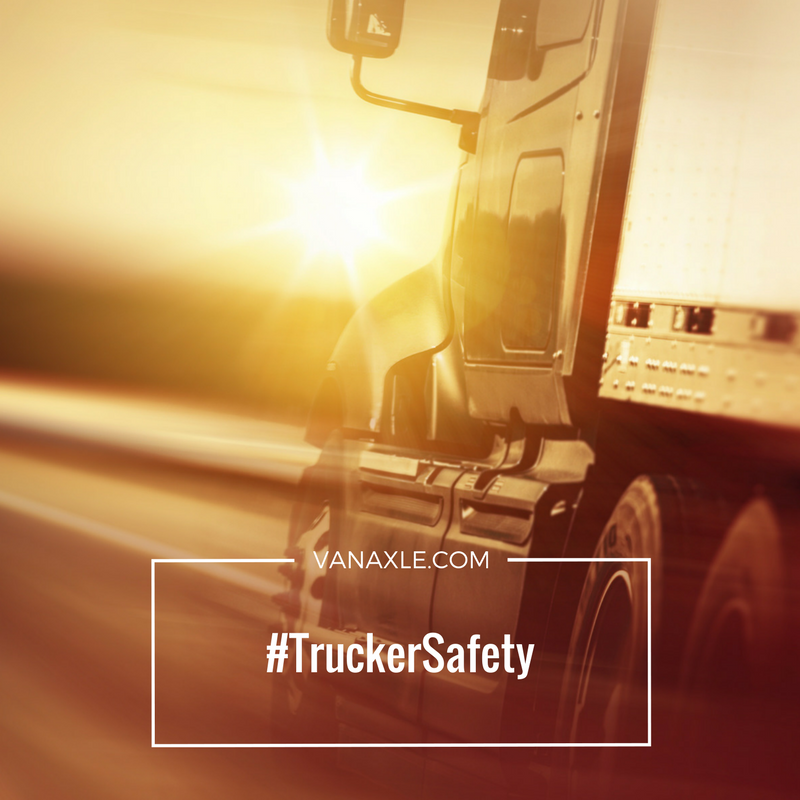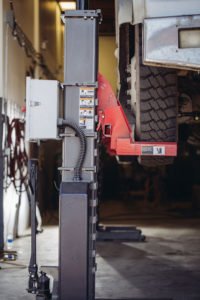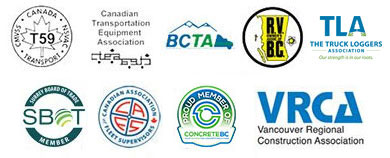That gently-used heavy-duty truck you’ve added to your fleet has gone through tires at an alarming rate. It’s also a huge gas hog, and your driver complains of backaches after a long haul. You’re referred to the shop of a heavy-duty truck mechanic who speculates that your truck may have been in an accident which caused one wheel to sit back further than the other. The misaligned wheel had been the culprit of the ongoing short tire life, gas guzzling, and driver discomfort. Looks like it’s time for a wheel alignment.
Without a proper alignment, driving can become unsafe and expensive. Misaligned wheels are often the source of handling problems, driver fatigue, decreased fuel efficiency, excessive wear and tear on tires, and higher maintenance costs on components.
As fuel and tires account for the two highest operational costs of a trucking company, wheel alignment can help control these costs. Below we will discuss the benefits of alignment in a heavy-duty truck, along with signs and symptoms and causes and effects of misalignment.
Heavy-duty truck owners put themselves and others in danger by skipping wheel alignments
If you were to randomly select a number of heavy-duty trucks on the road today, particularly highway tractors, you would likely find at least a degree of misalignment in the majority of them. Mike McCoy of Bee Line estimates that about half the trucks and trailers on the road today are out of alignment.
Alignments are an essential part of preventative maintenance in heavy-duty trucks. Often, the cost of new tires far exceeds the cost of regular alignments, and trucks with misaligned wheels can experience tire drag, which can burn up fuel at an alarming rate. The worst-case scenario for opting out of wheel alignments is experiencing a tire blowout or other accident resulting from loss of control of a misaligned truck.
Causes of wheel misalignment
Road conditions
Driving over poorly maintained or gravelly stretches is sometimes unavoidable. If you regularly travel over roads potholed in Swiss-cheese style, your alignment may be in trouble. The same applies if you tend to slam your wheels on curbs when turning, have recently been in an accident (even a minor one can affect the frame of your truck), or just fail to maintain your truck: you may have shocked your chassis. You may have affected how your tires sit and altered your alignment.
Hitting one deep pothole at a high speed is all it takes to tear open a tire, throw your truck’s wheels out of alignment, not to mention damage your suspension, shocks, steering, and other parts.
Driving behaviors and payloads
In addition to road conditions, your driving habits and your payloads will affect your tires. Barreling over speed bumps, braking hard, and cornering maniacally can adversely affect tires; the same goes for hauling loads with a high center of gravity. These types of behaviors and loads can cause portions of tire surface to peel off, which causes a weight imbalance of the tires and a wobbly vibration in the steering wheel. With wear and tear on the tread, the tires are less able to grip the road and respond in an emergency. Such tire drag also minimizes fuel efficiency.
Signs and symptoms of poor wheel alignment
Handling problems
- Tires will be slightly off center, which will be noticeable when you try to steer the truck.
- Your truck will be difficult to maneuver. It might pull in a different direction when you let up on the steering wheel and coast on a flat surface. Note that pulling problems can also be caused by unequal air pressure in tires, malfunctions in brakes, problems with power steering, and other causes.
- Steering will be less responsive and not level when driving; you’ll be overcorrecting and working too hard just to keep your truck in a straight line.
- The steering wheel fails to naturally begin to return to center after making a turn.
- The wheel might be shaky. They may vibrate at certain speeds but not at others.
- The truck might feel off-balance even on level ground.
- When braking, the truck veers to the left or right.
- Tires will not grip the road as they once did, compromising safely.
- Sloppy, loose steering when cornering; diminished feeling of control.
Tire problems
Don’t automatically blame your tires for excessive or irregular wear. The tires may only be exhibiting the signs and symptoms of the actual cause: an alignment problem. When you inspect your tires, you might notice:
- Uneven, premature, or excessive tire wear. This is a classic sign of misalignment. On a close inspection of your tires, you may discover hideous tread patterns. Tires that are not in alignment wear out prematurely since they endure a constant drag on their tread. You may notice excessive wear on the inside edge of the tire or on the outside edge. Other causes of uneven wear can be tire and wheel imbalance or inadequate tire inflation pressure.
- Shoulder wear and center wear: Excessive wear on the outside shoulder of the tire tends to result from underinflated tires. Wear in the tire’s center often signals overinflated tires.
- Feathering: May signal a problem with the toe adjustment. With the condition of feathering, the edge of each tread rib develops a slightly rounded edge on one side and a sharp edge on the other side. Run your hand from the outside of the tire to the inside. When you can feel the sharp edges as you move your hand inward, you will need more toe-in. When you feel the sharp edges moving from the inside of the tire to the outside, you will need less toe-in.
- Cupping: Cups or scalloped dips you may find near the edge of the tread. May be a sign of irregular wear related to tire inflation. Usually a result of worn suspension components.
- Check the air pressure of your tires. Inadequate tire inflation pressure can mimic the signs of misalignment.
Don’t send your battered tires to the scrap heap just yet
Keep your tires on the truck and get to your mechanic for an alignment check. The mechanic will examine the tire and wheel position so that the cause of the wear can be identified. Maybe the culprit will be traced back to the truck or axle. Know that you’ll never find the cause if you remove the offending tire from your truck.
Early signs of irregular wear can be caught early in the life of a tire, often in the first 20% to 30% of its life. Caught early, a tire can sometimes be saved by remounting it or moving it to a different wheel position.
When tires themselves are the cause of the problem. Sometimes a tire is the culprit of its problems. Minimize risk by avoiding cheaply made tires, which tend to have poor design and a short life expectancy. Also, do not use the wrong tires for the wrong application (such as buying tires with a tread that is too aggressive for over-the-road use).
Happily, most types of tire wear are preventable through regular maintenance.
Effects of driving a misaligned truck
Driver discomfort
Attempting to drive a truck with alignment problems can be physically taxing since you must constantly correct the steering wheel, which can cause neck, back and shoulder pain, not to mention exhaustion, frustration, and burnout.
Your level of discomfort will depend on how often you drive the truck and how misaligned it is. A misaligned truck can compromise safety, reduce productivity, and adversely affect driver job satisfaction. If you own a trucking company, you may experience a higher turnover in drivers who might seek employment with another trucking company (one who emphasizes safe, well-maintained trucks). In short, alignments are good for employee retention and the bottom line of a trucking business.
Safety concerns
- Misalignment stresses the suspension system of a truck. This could result in damage and costly repairs.
- Bad alignment can cause difficulty in steering, braking and handling. The driver is at high risk for an accident.
- High risk of tire blowout due to excessive tire wear from poor alignment. Blowouts are explosions of tremendous force that can cause a driver to lose control, veer into adjacent lanes, jackknife, or even roll over.
Blowouts can cause serious injury or death to other drivers, with tire rubber becoming a deadly projectile. Road alligators (big pieces of tire tread) left from tire blowouts can obstruct the road and cause a vehicle to swerve and crash or may cause damage to the chassis of a vehicle that passes over the alligator.
Wheel alignments correct the geometry of your wheels with respect to your chassis
When done correctly, an alignment places your tires perpendicular to the ground, parallel to each other, and pointing in the right direction. Your tires will rotate in a straight line, which will make for even tire wear and easy steering. During an alignment, angles are measured in tenths and hundredths of degrees or inches. What you may perceive as a “slight” misalignment can put you in danger of loss of tire traction or a tire blowout. Misalignment may adversely affect your steering and suspension and eat up tires and their related parts and adversely affect handling. Left unchecked, your steering and suspension can be affected.
At Vancouver Axle and Frame, serving the Fraser Valley, BC, we know that measurement and correction of all the major alignment angles is necessary to achieve maximum truck efficiency. That is why our equipment, designed and manufactured by Bee Line, promotes the concept of “Total Vehicle Wheel Alignment” to extend tire wear, maximize fuel efficiency, and improve vehicle handling. Total Vehicle Wheel Alignment means measuring and correcting all alignment angles, not just toe and rear tracking.
Make wheel alignments part of your maintenance schedule
As a result of increased tire and fuel costs, harmful emissions, and driver fatigue, many trucking companies have turned to our laser technology as a more accurate method of wheel alignment than the method mechanical gauge with manual calibration being carried out visually.
For the best results and the greatest cost savings for you, we recommend you get your wheels aligned every 12 months at a minimum.
You might want to coordinate your alignments to be done right before your annual safely inspections and keep your trucks on an ongoing schedule.
Between your annual inspections, monitor your tire wear regularly. Any uneven wear you see is a red flag for misalignment. It’s also a good idea to align any new vehicles you add to your fleet. And, of course, if your vehicle has been in an accident, recheck your calibration before putting that vehicle back on the road.









